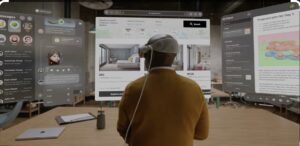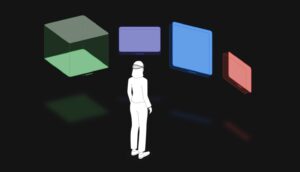Apple Vision Pro spatial computing device. Introduced at WWDC 2023, visionOS is conceptually similar to iOS but has been optimized for spatial computing. The system offers unique features tailored for 3D applications and immersive experiences. It supports hand and eye control mechanisms, an infinite canvas for applications, and resizable apps to fit the spatial computing environment.
3D Apps
visionOS is built to support 3D applications natively, enabling developers to create more immersive and interactive experiences. It integrates tools for developing 3D content, making it easier for developers to transition from traditional 2D app development.
Immersive Experiences
One of the key goals of visionOS is to create more immersive experiences for users. It does this through advanced technologies that allow for real-world interaction in a 3D space. This opens up new possibilities for applications in gaming, education, and professional use-cases.
Hand and Eye Control
visionOS introduces novel control mechanisms, including hand gestures and eye tracking. These controls allow for more natural interaction within the 3D space, making it easier for users to navigate and perform tasks.
Infinite Canvas
The operating system features an “infinite canvas,” a limitless workspace that users can customize to fit their needs. This canvas can host multiple apps and services simultaneously, allowing for a more flexible and personalized computing experience.
Resizable Apps
Apps in visionOS can be resized to fit the user’s spatial computing environment, allowing for a more adaptable and personalized experience. Users can move and manipulate apps as they would physical objects in a 3D space.
Developer Tools
visionOS comes with a set of developer tools designed to facilitate the creation of 3D apps and services. These tools are intended to make the development process more streamlined and to encourage innovation within the ecosystem.
Compatibility and Ecosystem
The document mentions that visionOS is compatible with existing Apple services and apps, ensuring a seamless transition for users and developers alike. It also indicates that the operating system will be open to third-party developers, fostering a vibrant ecosystem around spatial computing.
Future Uses:
Here’s a look at some potential future uses:
-
Healthcare
Spatial computing could revolutionize medical training and treatment. For example, visionOS could support applications that allow doctors to visualize complex medical procedures in 3D before performing them. It could also facilitate remote consultations, with doctors and patients interacting in a virtual 3D environment.
-
Education
The educational sector could benefit immensely from visionOS. Imagine a classroom where students can interact with historical events in 3D or explore complex scientific phenomena in an immersive environment. This could make learning more engaging and effective.
-
Architecture and Design
Architects and designers could use visionOS to create more detailed and interactive 3D models. This would enable clients and other stakeholders to walk through a virtual building or space, offering a more tangible sense of the final product before it’s built.
-
Retail and Shopping
visionOS could transform the online shopping experience by allowing users to try on clothes virtually or see how furniture looks in their home before making a purchase. This would bridge the gap between online and offline shopping experiences.
-
Entertainment
The entertainment industry could see a new level of interactivity and immersion. Imagine watching a movie or sports event where you can change your viewpoint at will or even walk around within the scene. Interactive storytelling could reach new heights.
-
Professional Training
From piloting aircraft to operating heavy machinery, spatial computing could make professional training more effective and safer. Trainees could practice in a simulated 3D environment, gaining valuable experience without the risks associated with real-world training.
-
Social Interaction
As social media evolves, visionOS could pave the way for more interactive and immersive social spaces. Virtual meetups, networking events, or even family gatherings could take place in 3D environments, providing a more engaging way to connect with people worldwide.
-
Augmented Reality Integration
Given Apple’s interest in AR, it’s likely that visionOS could integrate with AR technologies to provide a seamless blend of real and virtual worlds. This could be useful in navigation, gaming, and various other applications.
-
Environmental Monitoring
With a very promising future, Spatial computing could also be used for large-scale environmental monitoring and disaster response. For example, visionOS could support applications that provide real-time, 3D mapping of areas affected by natural disasters, helping to coordinate rescue and relief efforts more effectively.
In summary, visionOS has the potential to be a game-changer in how we interact with computers and the world around us. From healthcare and education to retail and entertainment, the possibilities are almost limitless. As the technology matures, it’s likely that we’ll see an increasingly broad range of applications that leverage the unique capabilities of spatial computing.


